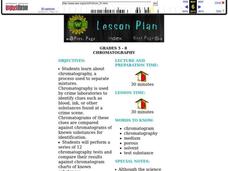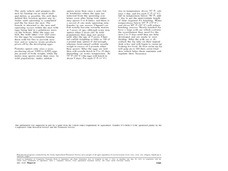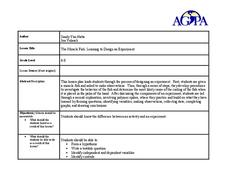Curated OER
Other Countries
Young scholars select a country and conduct research on the culture, population, geography, and government of their country. They conduct research using the Internet and a variety of resource books, and write and publish a report that...
Curated OER
Sled Kite
Learners make and fly a sled kite out of plastic garbage bags, dowel rods, and more. In this kite lesson plan, students plan the kite to have symmetry and make adjustments as they test it.
Curated OER
Oklahoma Ag in the Classroom
Students make tortillas. In this tortilla lesson, students add the ingredients to a bag, mix the ingredients, roll the tortillas out, and cook them. They spend 3 minutes coming up with as many round things as they can.
Curated OER
Chromatography
Students study about chromatography, a process used to separate mixtures.
Curated OER
Classification in Action
Students work with a set of objects to set up both quantitative and qualitative classification systems. As a group, students follow an example to design and complete two classification systems using a set of objects provided. ...
Curated OER
Shape Makers
Classify and explore shapes by giving learners opportunities to handle, describe and classify 2D and 3D shapes. Primary learners will sort objects such as triangles, squares, oblongs, circles, ovals, pentagons, hexagons, diamonds, boxes,...
Curated OER
Channel Catfish
Students study the life and biology of the Channel Catfish. In this aquatic biology instructional activity, students will examine the external and internal features of the catfish along with their breeding habits and environment. This...
Curated OER
Inscribed Quadrilaterals and Parallelograms
Learners differentiate between inscribed quadrilaterals and parallelograms. In this geometry lesson, students identify the shaped of the polygons when it is inscribed inside of a circle. They calculate the missing angles of the inscribed...
Curated OER
As a Matter of Fact!
Students explore matter. They use a formula to measure the volume of matter.
Curated OER
Exploring Function Graphs
Tenth graders investigate three different sets of data that relate temperature to another variable in the physical world. These illustrate linear, inverse and exponential relationships.
Curated OER
New Kids on the Block
Second graders identify and describe in their own language, the following 2-dimensional and 3-dimensional shapes: triangle, square, oblong (non-square rectangle), circle, oval, pentagon, hexagon, diamond, box, cylinder, and sphere. They...
Curated OER
Introduction To the Classification of Organisms
Students discuss how scientists classify organisms. In pairs, they analyze and label "specimens" of breakfast cereals in order to classify them into the correct group. They create a dichotomous key for several species of animals.
Curated OER
Experimenting with Physical Changes
Fourth graders explore physical changes. They discuss that physical change is a change in size, shape, or state of matter of a substance. Students explore what change takes place when two substances can dissolve each other. They observe...
Curated OER
Understanding Zoning: Its use on the High Line in West Chelsea
Students are introduced to zoning. Evaluating information and reading a land-use map is enclosed in this lesson. List new development projects that they could propose for a given area.
Curated OER
Out and About-Creating Design
Students demonstrate the elements of design by creating a digital photography portfolio of photos taken in and arond the scool. The edit photos using Photoshope to emphasize the element of desing in each phot.
Curated OER
Slope Right Up
Middle schoolers use triangles to find the length and slope of each side. After connecting the vertices, they add points based on their specific instructions. They use the Pythagorean Theorem to complete a worksheet to end the lesson.
Curated OER
The Family
In this family in American society worksheet, students respond to 7 short answer questions and answer 15 vocabulary matching questions regarding the institution of family in different cultures.
Curated OER
The Miracle Fish: Learning to Design an Experiment
Young scholars develop procedures to explore the behavior of fish. In this scientific experiment lesson students from a hypothesis, write a question, identify different variables and controls in their experiment.
Curated OER
Betrayal of Penn's Promise - The Walking Purchase
Pupils role-play the 1737 Walking Purchase. In this Pennsylvania history lesson, young scholars role-play the 1737 Walking Purchase and analyze its effects. Pupils also consider how it would affect their community today.
Curated OER
Who Lives in the Arctic North?
Students study the Arctic North. In this Canada history lesson, small groups of students research and then teach the class about either the plants, animals, humans, or geography in relation to the Arctic North. Students make their own...
Curated OER
We the People... How Does Government Secure Natural Rights?
High schoolers investigate the Founders' ideas about what kind of government is most likely to protect the basic rights of people. They distinguish between limited and unlimited government.
Curated OER
Spiders and Their Body Parts
Students gain an understanding of the different parts of spiders by observing and drawing a spider. They utilize technology in order to gain a better understanding of spiders and their body parts.
Curated OER
How Animals Meet Their Needs
Fourth graders research the Internet for facts relating to the animal of their choice. They use information from their Internet search to complete their animal project. TLW use his or her own words when writing their report.
Curated OER
Spiders - KidPix
Students answer questions after a story is read aloud, identify and recall the three major body parts of a spider (head, body and 8 legs), construct a spider when given parts of a spider on a handout, and draw and decorate a spider using...

























